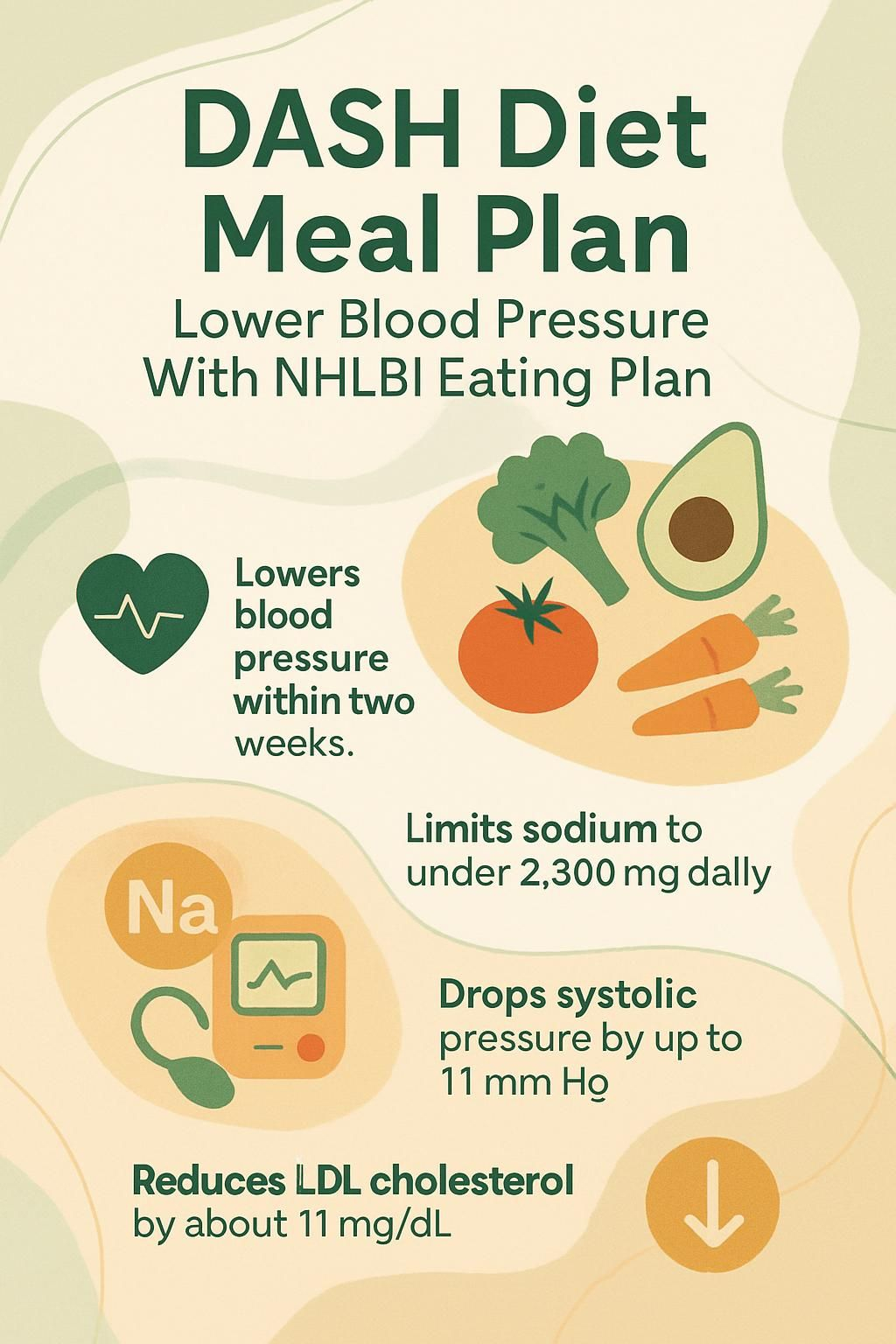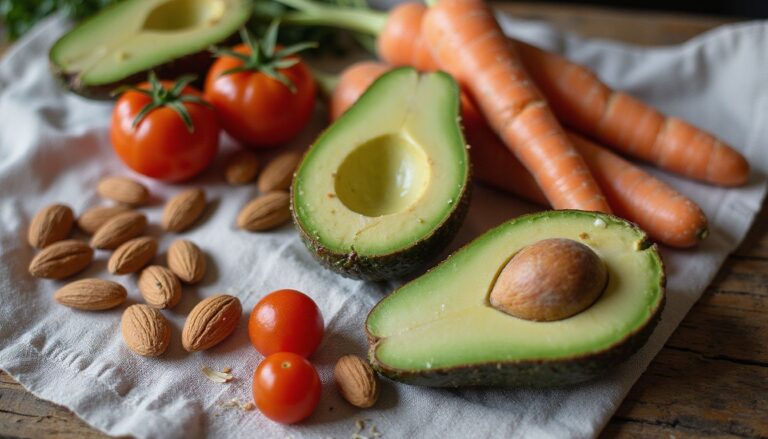DASH Diet Meal Plan: Lower Blood Pressure With NHLBI Eating Plan
Our Nutrition Assistant AI Suite will transform your body. You will lose fat, get toned, and build muscle. Gain confidence and optimal health.
High blood pressure can be confusing and stressful. The DASH Diet Meal Plan, created by the National Heart, Lung, and Blood Institute (NHLBI), is a proven eating plan that can start to lower blood pressure in about two weeks.
I reviewed research and official guidance to find what truly helps. In this guide, you will learn why DASH works, how to fit it into daily life, and which foods support a strong heart.
Keep reading for clear steps backed by real data.
Key Takeaways
- The DASH Diet, tested in NHLBI clinical trials with more than 450 adults, can lower blood pressure within two weeks.
- This eating plan centers on fruits, vegetables, whole grains, low-fat dairy, and lean protein. It limits sodium to below 2,300 milligrams per day.
- Studies show DASH can drop systolic blood pressure by up to 11 mm Hg and lower LDL cholesterol by about 11 mg/dL in several weeks.
- Following DASH supports weight control and lowers risk for heart disease and type 2 diabetes compared with a typical Western diet.
- Success requires meal planning and limiting processed foods that are high in sodium and unhealthy fats, as NHLBI research recommends.

What is the DASH Diet and Why Was It Created?

The DASH eating plan is flexible and balanced. It helps lower high blood pressure while improving overall nutrition.
What Does DASH Stand For and What Is Its Purpose?
DASH stands for Dietary Approaches to Stop Hypertension. Hypertension means high blood pressure. The goal is simple. Eat foods rich in potassium, calcium, and magnesium, and limit sodium and saturated fat.
NHLBI developed DASH after research showed many people can lower blood pressure with diet changes. I started following DASH after my doctor recommended a plan built around whole grains, fruits, vegetables, lean meats, and low-fat dairy. It made cutting sodium and calories easier.
Health professionals recommend DASH because it supports heart-healthy habits and can also help with weight and cholesterol control.
How Did NHLBI Develop the DASH Diet?
NHLBI researchers created DASH in the early 1990s using controlled feeding trials. More than 450 adults completed eight-week studies to compare diets and measure blood pressure changes.
One group ate a typical American diet high in sodium. A second group added more fruits and vegetables to a usual diet. A third group followed what became DASH, which features fruits, vegetables, low-fat dairy, whole grains, nuts, beans, poultry, and fish, with less red meat and added sugars.
Blood pressure started dropping within days on the DASH pattern, even without weight loss. These results led to the guidelines people follow today.
“In just two weeks of following DASH principles, adults with hypertension showed significant drops in systolic and diastolic blood pressures.”
Key Principles of the DASH Diet for Healthy Eating
I focus on DASH basics to protect my heart. The plan emphasizes nutrient-rich foods with less salt and more fiber.
Why Should You Prioritize Fruits and Vegetables?
Fruits and vegetables supply potassium, fiber, and vitamin C. These nutrients help lower blood pressure and support blood vessels. NHLBI studies link higher intake with lower risk of heart disease.
When I added at least four to five servings daily, cravings improved and snacks got easier. Swapping chips for an apple or carrot sticks cut my urge for salty foods.
Many people fall short on produce. Choosing fruit over sweet drinks or candy also helps manage calories and weight.
How to Choose Whole Grains on the DASH Diet?
I replace white bread and pasta with whole grains. Labels help me find 100 percent whole wheat bread, brown rice, oatmeal, and whole-grain pasta.
For breakfast, I pick old-fashioned oats instead of pancakes made with refined flour. DASH suggests at least half of daily grains come from whole sources. One slice of 100 percent whole-wheat toast or a half cup of cooked brown rice counts as a serving.
Whole grains offer more fiber than refined grains, so I stay full longer and support healthy blood pressure and cholesterol.
What Are the Benefits of Low-fat Dairy Products?
Low-fat dairy, like 1 cup of low-fat milk or yogurt, provides protein and calcium with less saturated fat. Studies show swapping full-fat dairy for low-fat options can reduce LDL cholesterol, which lowers heart disease risk.
NHLBI research links low-fat dairy with better blood pressure. I had fewer cravings when I added a low-fat cheese stick or used nonfat milk at breakfast. People with type 2 diabetes or kidney concerns can also benefit because these choices reduce saturated fat and sodium.
Why Opt for Lean Meats, Fish, and Poultry?
Lean meats, fish, and poultry contain less saturated fat than fatty meats. That helps protect the heart. Research shows choosing lean proteins, like chicken or turkey, can cut saturated fat intake compared to processed or fatty meats.
Fish such as salmon adds healthy fats that support cholesterol levels. In my first week on a sample DASH plan, swapping steak for baked chicken or broiled fish made me feel lighter and more energetic. These proteins also help me control sodium because they are less processed.
How Can You Reduce Sodium Intake Effectively?
Reducing sodium lowers blood pressure and supports diabetes management. These steps make it practical.
- Check labels for sodium per serving. Low sodium means 140 milligrams or less.
- Limit processed foods such as canned soup, pickles, deli meats, and salty snacks.
- Pick fresh fruits and vegetables often. They are low in sodium and high in potassium.
- Cook at home more often. You control portions and the salt you add.
- Use herbs, spices, lemon juice, or vinegar for flavor instead of salt.
- Choose unsalted nuts and seeds for snacks.
- Select plain whole grains like brown rice or oatmeal instead of instant flavored grains.
- Rinse canned beans and vegetables to wash away some added salt.
- Track daily sodium with an app or log. Following DASH can lower both systolic and diastolic pressure.
- Reduce salt gradually so your taste buds can adjust.
What Are Healthy Fats to Include in Your Diet?
Unsaturated fats from olive, canola, or sunflower oil can support heart health. I add avocado to salads or snack on a small handful of unsalted nuts.
Seeds like flax and chia provide omega-3 fats that improve cholesterol. Choosing lean meats over fatty cuts limits saturated fat, which helps blood pressure. Healthy fats also keep me satisfied, so I avoid salty or sugary processed foods.
How Does the DASH Diet Improve Your Health?
DASH helps manage blood pressure and lowers risk for several chronic diseases. The benefits build over time and can be measured by real numbers.
How Does the DASH Diet Lower Blood Pressure?
Eating fruits, vegetables, and low-fat dairy helps me keep sodium in check. Potassium and magnesium balance the effects of salt. This supports relaxed blood vessels and steadier pressure.
I avoid processed snacks that tend to be salty. Lean meats, whole grains, nuts, and seeds give me the nutrients I need without extra saturated fat. Studies show up to an 11 mm Hg drop in systolic pressure within 14 days.
Can DASH Reduce Your Risk of Heart Disease?
DASH improves heart health by focusing on sodium control, potassium, fiber, and smart fats. NHLBI data show fewer cardiovascular events for people who follow the plan compared with a typical Western diet.
Magnesium and calcium also support healthy blood vessels. With more fruits, vegetables, whole grains, and low-fat dairy, cholesterol often improves and artery inflammation may decrease. Study results point to lower risk of stroke and heart attack within several years.
Does the DASH Diet Help with Weight Management?
DASH encourages nutrient-dense foods while trimming empty calories. People who follow the plan tend to reduce sugary snacks, fatty meats, and highly processed items.
Fiber from vegetables and whole grains helps you feel full, which makes overeating less likely. Pairing DASH with regular activity supports steady weight loss. Planning portions made weight control easier for me without fad rules.
How Does DASH Improve Cholesterol Levels?
Meals rich in fruits, vegetables, and whole grains can lower LDL cholesterol. NHLBI studies show average reductions of about 14 mg/dL for total cholesterol and 11 mg/dL for LDL after several weeks.
Soluble fiber binds some cholesterol in the gut. I replaced fatty meats with chicken or fish. My labs improved, and HDL, the good cholesterol, stayed steady.
| Nutrient or Food | Goal | Expected Effect |
|---|---|---|
| Fiber | Higher intake | Lowers LDL |
| Saturated fat | Limit | Reduces heart risk |
| Cholesterol-rich foods | Minimal | Protects arteries |
These changes supported better numbers without making meals bland.
Can DASH Lower Your Risk of Type 2 Diabetes?
Research shows a DASH-style pattern is linked to a lower risk of type 2 diabetes. The focus on fruits, vegetables, whole grains, and low-fat dairy supports stable blood sugar.
I feel more even energy when I build meals from these foods. Fiber and limited added sugars support healthy insulin response. These steps align with general guidance for diabetes prevention.
What Does a Typical DASH Diet Meal Plan Look Like?
DASH uses simple foods that fit into daily life. I build meals around fruits, vegetables, lean proteins, and whole grains to support lower blood pressure.
What Are Healthy DASH Breakfast Options?
A steady breakfast sets the tone for the day. These ideas are quick and balanced.
- Oatmeal with low-fat milk and sliced banana for fiber, calcium, and potassium.
- Whole-grain toast with natural peanut butter for complex carbs and healthy fats.
- Greek yogurt with berries for protein, potassium, and antioxidants.
- Scrambled egg whites with sautéed spinach for lean protein and iron.
- Smoothie with skim or fortified soy milk, banana, strawberries, and a handful of spinach.
- Cottage cheese with chopped peaches for protein and modest sodium.
- High-fiber whole-grain cereal plus kiwi or orange segments for more potassium.
- Breakfast burrito with egg whites, black beans, tomatoes, and peppers.
- Overnight chia pudding in unsweetened almond milk for omega-3 fats and calcium.
These options follow core DASH principles. Clinical trials show meaningful blood pressure drops with this pattern.
What Should You Eat for Lunch on DASH?
Lunch should keep energy steady and fit the plan. These steps help me build a balanced plate.
- Choose whole-grain bread, pita, or brown rice for fiber.
- Add lean protein such as grilled chicken, turkey, or tuna packed in water.
- Include at least one cup of vegetables for potassium and antioxidants.
- Use low-fat dairy like sliced mozzarella or yogurt-based dressing.
- Add unsalted nuts or a spoonful of seeds for healthy fats and magnesium.
- Flavor with herbs instead of salty condiments to keep sodium below 2,300 milligrams.
- Include fruit on the side for vitamins and natural sweetness.
- Pick water or unsweetened tea for hydration without extra sugar.
- Prep lunch ahead in containers to support portion control and consistency.
What Is a Balanced DASH Dinner?
Dinner follows the same steady pattern to support heart health.
- Fill half the plate with non-starchy vegetables like broccoli, spinach, or carrots.
- Add a lean protein such as grilled chicken, fish, or beans.
- Include a whole grain like brown rice or whole wheat pasta.
- Choose low-fat dairy such as skim milk or yogurt.
- Use a small portion of unsalted nuts or seeds for healthy fats and magnesium.
- Season with herbs, garlic, lemon juice, and pepper instead of salt.
- Use baking, steaming, roasting, or grilling instead of frying.
- Watch portions. Most adults need about 2 to 3 ounces of cooked protein per meal.
- End with fresh fruit for dessert to add potassium and limit added sugar.
This keeps sodium in check while covering all the core food groups.
What Are Good DASH Snacks to Choose?
Smart snacks prevent overeating later. I keep these on hand for busy days.
- Fresh fruit such as apples, oranges, or berries.
- Raw vegetables like carrots, cucumber, or bell peppers with hummus.
- Unsalted nuts such as almonds or walnuts for healthy fats.
- Low-fat yogurt for calcium and protein, choose plain versions.
- Whole-grain crackers with low-sodium turkey for a hearty bite.
- Air-popped popcorn without butter for a high-fiber crunch.
- Cottage cheese with pineapple chunks for protein and vitamins.
- Avocado on whole-grain toast for potassium and satiety.
- Hard-boiled eggs prepared ahead for quick protein.
How to Follow a Weekly DASH Diet Menu
A weekly menu keeps me organized and balanced. It also helps me control sodium and portions.
What to Eat on Day 1: Fruits and Lean Protein?
I start with a bowl of mixed berries for fiber and antioxidants. For protein, I choose scrambled egg whites or grilled turkey breast.
At lunch and dinner, I fill half the plate with leafy greens and add fruit such as orange slices. Grilled chicken or roasted fish provides lean protein. For snacks, I pick melon, grapes, or nonfat Greek yogurt.
This mix supports blood pressure with potassium and fiber, while lean protein keeps saturated fat low.
What to Focus on Day 2: Whole Grains and Low-fat Dairy?
On Day 2, I focus on whole grains and low-fat dairy. Oatmeal at breakfast or brown rice at lunch works well.
Low-fat milk, yogurt, or reduced-fat cheese adds calcium with less saturated fat. NHLBI studies show two to three daily servings of low-fat dairy support better blood pressure control. For snacks, plain nonfat Greek yogurt with fruit or cottage cheese on salads fits the plan.
What Are High-fiber Vegetable Dishes for Day 3?
I prepare a lentil and roasted vegetable salad with carrots, broccoli, and red peppers. One serving offers about 8 grams of fiber with modest sodium.
Another favorite is sautéed kale with chickpeas. It adds around 6 grams of fiber per serving while keeping fat low. Both choices boost potassium, magnesium, and fiber through vegetables and legumes.
How to Balance Meals with All Food Groups Days 4-7?
I include all food groups at each meal. Breakfast might be whole-grain toast with low-fat cheese and berries. Lunch could be brown rice, grilled chicken, greens, and a small portion of beans. For dinner, I pick baked salmon or lean turkey with steamed broccoli and roasted sweet potatoes.
To keep sodium below 2,300 milligrams per day, I season with herbs like basil or oregano. Snacks such as sliced apples with low-fat yogurt help me meet fruit and dairy goals without extra sugar or fat.
Which Foods Are Recommended on the DASH Diet?
DASH highlights foods rich in minerals that support blood pressure. Variety makes the plan easier to follow.
What Are High-potassium Foods to Include?
Bananas, sweet potatoes, and spinach are rich in potassium. Avocados provide potassium and healthy fats. Beans such as kidney or white beans are excellent options.
Potatoes with skin, oranges, tomatoes, cantaloupe, and yogurt often provide more than 400 milligrams per serving. Milk also supports daily potassium goals. These foods help counter the effects of sodium.
Which Calcium-rich Foods Support DASH?
Low-fat and fat-free dairy, like milk, yogurt, and cheese, fit the plan. One cup of low-fat milk has about 300 milligrams of calcium for bone health.
I often pick plain Greek yogurt for more protein and calcium. Leafy greens such as collards, turnip greens, bok choy, and kale also provide calcium. Fortified soy milk is a good choice if you do not drink regular milk.
What Are Good Sources of Magnesium?
Beans, nuts, and seeds are reliable sources. I add almonds to breakfast or snack on pumpkin seeds. Cooked spinach delivers about 157 milligrams per cup. Whole grains like brown rice and quinoa help too.
Black beans, kidney beans, and lentils contribute magnesium. Milk and yogurt also help me meet daily needs while staying within the DASH pattern.
What Foods Should You Avoid on the DASH Diet?
Some foods make blood pressure management harder. Knowing which ones to limit keeps me on track.
Why Avoid High-sodium Processed Foods?
Processed foods can push daily sodium above 2,300 milligrams, the NHLBI limit. Salt makes the body hold extra water, which raises blood pressure and strains the heart.
Packaged snacks, canned soups, deli meats, and frozen meals often contain hidden sodium. I used to rely on quick frozen dinners. My blood pressure improved after I moved to fresh meals guided by DASH.
What Sugary Snacks and Drinks Should You Skip?
I avoid candies, cookies, and cakes because they are high in added sugars. Soda, sweetened tea, energy drinks, and sports drinks can add dozens of grams of sugar in one serving.
I check labels for high-fructose corn syrup and juice concentrates. During meal planning, I found that fruit and whole grains reduced my sugar cravings. Water with lemon or plain sparkling water helped me cut extra calories.
Which Fatty Meats and Full-fat Dairy Are Not Recommended?
Bacon, sausage, ribs, and regular ground beef are high in saturated fat, which raises LDL cholesterol. Processed lunch meats like salami and bologna are often high in both sodium and unhealthy fats.
Whole milk, cream, full-fat cheese, butter, and ice cream are not recommended on DASH. Switching to skim milk helped my blood pressure numbers improve within months.
How Can You Stick to the DASH Diet Successfully?
Small, steady habits make DASH easier. I rely on planning, smart shopping, and low-sodium flavor boosters.
Why Is Meal Planning Important on DASH?
Planning helps me control sodium, fat, and calories. Mapping out recipes for the week simplifies shopping and portion control.
A schedule prevents last-minute fast food, which often contains a lot of salt. Using an NHLBI-style meal planner added more variety to my plate and made my blood pressure easier to manage.
How to Monitor Sodium on Food Labels?
Reading labels is essential on the DASH Diet Meal Plan. Here is my checklist.
- Check the sodium line on the Nutrition Facts panel. Aim for less than 2,300 milligrams per day, or 1,500 if you have hypertension.
- Compare similar items and choose the lower sodium option.
- Ignore front-of-package buzzwords. Focus on the Nutrition Facts box.
- Watch serving sizes. Adjust if you will eat more than one serving.
- Scan ingredients for hidden sodium such as monosodium glutamate, baking soda, baking powder, or broth.
- Choose items labeled low sodium or no salt added.
- Be cautious with reduced-sodium items. They may still be high.
- Limit canned soups, frozen meals, and deli meats when possible.
- Use a daily log to total your intake.
- Switch brands if another has better DASH-friendly numbers.
How to Use Herbs and Spices for Flavor?
Flavor does not need salt. I rotate herbs and spices to keep meals interesting.
- Use basil, oregano, and dill for salads, soups, and roasted vegetables.
- Season lean meats with garlic or onion powder instead of salty mixes.
- Add black pepper, paprika, or chili powder to eggs and stews.
- Grate lemon or lime zest over grains or yogurt for brightness.
- Stir cinnamon into oatmeal or yogurt for gentle sweetness.
- Make your own no-salt seasoning blends with thyme and rosemary.
- Add ginger to stir-fries, smoothies, or baked fish for fragrance.
- Finish dishes with fresh parsley or cilantro for a fresh note.
- Use crushed red pepper flakes sparingly for heat.
- Rotate flavors weekly so meals never feel repetitive.
What Is the Best Way to Gradually Reduce Sodium?
Small steps help your taste buds adjust. These changes made the process easier for me.
- Track daily sodium with a journal or app to spot the biggest sources.
- Pick reduced-sodium or no-salt-added staples like beans, tomato sauce, and broth.
- Cook more at home so you control the salt.
- Rinse canned vegetables and beans to lower sodium content.
- Season with lemon juice, garlic powder, onion powder, or pepper instead of salt.
- Taste before salting. Cravings usually drop in two to three weeks.
- Choose products with less than 140 milligrams per serving when possible.
- Plan meals around fresh produce and unsalted nuts.
- Make one or two changes each week to build lasting habits.
Common Questions About the DASH Diet Answered
Here are quick answers to questions I hear most often. Clear expectations make changes easier.
Is the DASH Diet Suitable for Everyone?
People with chronic kidney disease should talk with a clinician before starting DASH. Some foods are high in potassium and phosphorus, which may not fit every medical plan.
DASH focuses on whole grains, fruits, vegetables, and low-fat dairy to lower blood pressure. Children, pregnant women, and people with special dietary needs may need adjustments. Some heart or kidney medicines affect how the body handles minerals. A healthcare professional can guide safe changes.
Can You Lose Weight on the DASH Diet?
Yes, weight loss can occur because DASH limits sugary snacks, processed foods, and fatty items. The plan relies on whole grains, fruits, vegetables, lean meats, and low-fat dairy.
Studies suggest a modest loss over two months when calories are controlled. I felt less hungry as I cut sodium and ate more fiber-rich foods like beans and brown rice. Careful portions create a calorie gap while keeping meals balanced.
How Quickly Does DASH Lower Blood Pressure?
NHLBI trials show systolic blood pressure can drop within two weeks of starting DASH. Some people see an 8 to 14 point decrease in that time.
My numbers improved after I reduced sodium and focused on fruits, vegetables, low-fat dairy, and whole grains. Even small drops matter for heart health.
Conclusion
The DASH Diet meal plan helps lower blood pressure and supports heart health. I feel better when I build meals around fruits, vegetables, whole grains, lean proteins, and low-fat dairy. Research from NHLBI and other respected groups backs these benefits, including reduced risk for heart disease and type 2 diabetes.
This article is educational and not medical advice. If you have health conditions or take medication, speak with your healthcare provider before making major diet changes. Small, steady steps with the DASH diet can add up to lasting results.
FAQs
1. What is the DASH diet meal plan and how does it help lower blood pressure?
The DASH diet, created by the National Heart, Lung, and Blood Institute (NHLBI), focuses on eating more fruits, vegetables, whole grains, lean proteins like poultry or fish, and low-fat dairy products. Clinical studies show that following this plan can reduce systolic blood pressure by up to 11 points in people with high readings. The approach limits sodium intake while increasing nutrients such as potassium and magnesium that support heart health.
2. Which foods should I eat or avoid on the DASH diet?
Eat plenty of fresh produce; choose whole grain bread instead of white; select skinless chicken or seafood over red meat; use fat-free milk rather than cream; snack on unsalted nuts instead of chips. Avoid processed meats like sausage or bacon due to their high salt content. Limit sugary drinks and desserts since they add calories without nutrition.
3. How much sodium does the NHLBI recommend for those following a DASH meal plan?
The NHLBI suggests keeping daily sodium below 2,300 milligrams for most adults but notes greater benefits at 1,500 milligrams per day if you have hypertension or are sensitive to salt. Reading food labels helps track your intake accurately.
4. Can you share a personal example of using the DASH eating plan?
After my doctor recommended lowering my blood pressure last year, I switched from salty snacks to fruit cups packed in water and swapped out canned soups for homemade vegetable stews with herbs instead of added salt. Within two months my average reading dropped from 138/88 mmHg to 124/80 mmHg according to clinic records.
Summary: The NHLBI’s DASH meal plan uses research-backed guidelines that emphasize nutrient-rich foods while limiting sodium and unhealthy fats. Following these steps supports healthy blood pressure levels based on clinical evidence and real-life results.







